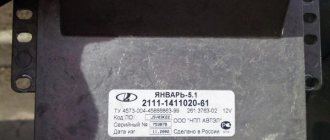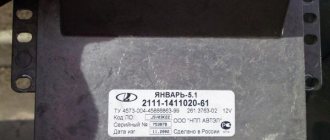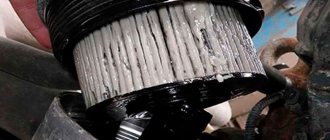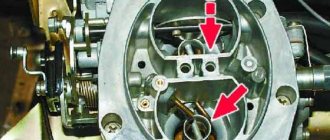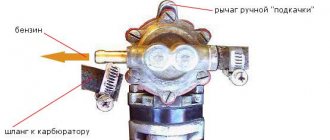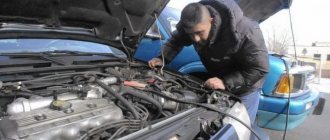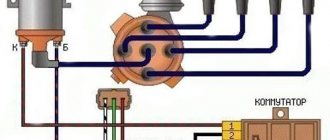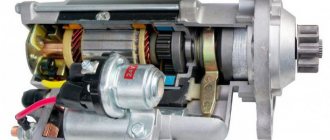- Posts: 4
June 3, 2014, 20:50 #1 123
Please help. The eye can start without problems only once a day, on the first try after standing for a long time (overnight), it doesn’t stall, the second time, if you’re lucky, only after an hour or more. When trying to start, there is no snorting (snorting), only the starter can be heard. I planted the battery and charged it again. I replaced the switch with a new one, replaced one spark plug with a new one, checked the electrics. magnetic valve - no change.
- Posts: 42
- From: Povolzhsky, Orenburg
- Oka 11113
November 25, 2014, 21:04 #2 123
So so so. I thought it was only me who had this problem. It's a pity that there are no answers or advice. They said the bendix doesn’t recline (well, it doesn’t work, in short), once twice for 30 minutes it stood and tried to start. Then I took it to the service center and the candles were full. It was advised to start it in such cases without suction and gas. Just try to catch the moment when the starter and engine are heard and then accelerate a little. This is if the car has not cooled down.
I don’t know how I explained it, I hope whoever needs it will get the gist.
- Posts: 154
- From: Voronezh 36
November 25, 2014, 10:19 pm #3 123
The internal combustion engine of the OKA system has two cylinders, etc. but structurally these two cylinders work as ONE (the sound of a running internal combustion engine is like that of a sewing machine)! If the spark plug is faulty, the engine will not start.
- Posts: 589
- From: Zhigulevsk
- Chevrolet Niva LC Vortex Estina
November 26, 2014, 09:50 #4 123+ 1
A warm Okushka should be started without choke, you can give it a little boost, depending on your situation. And also, check the level in the float chamber. If the level is too high, it overflows into the cylinders when it’s hot, so it won’t start when it’s hot, it floods the spark plugs.
- Posts: 2964
- Oka SeAZ 11113
November 26, 2014, 14:17 #5 123+ 1
oklick, November 25, 2014, 10:19 pm, #3
The internal combustion engine of the OKA system has two cylinders, etc. but structurally these two cylinders work as ONE (the sound of a running internal combustion engine is like that of a sewing machine)! If the spark plug is faulty, the engine will not start.
I beg to differ! Oka with an adjusted carburetor and ignition starts normally on ONE working spark plug and even drives.
Sergey 67, June 3, 2014, 20:50, #1
Help me please. The eye can start without problems only once a day, on the first try after standing for a long time (overnight), it doesn’t stall, the second time, if you’re lucky, only after an hour or more. When trying to start, there is no snorting (snorting), only the starter can be heard. I planted the battery and charged it again. I replaced the switch with a new one, replaced one spark plug with a new one, checked the electrics. magnetic valve - no change.
The carburetor overflows (high level), that is, the composition of the combustible mixture differs from normal, either there is little fuel (the spark plugs are dry) and a lot of air, or (as in your case) a lot of fuel and little air. It is necessary to adjust the carburetor (and in particular the starting device in it).
- Posts: 13
November 29, 2014, 00:41 #6 123
Sergey 67, June 3, 2014, 20:50, #1
Help me please. The eye can start without problems only once a day, on the first try after standing for a long time (overnight), it doesn’t stall, the second time, if you’re lucky, only after an hour or more. When trying to start, there is no snorting (snorting), only the starter can be heard. I planted the battery and charged it again. I replaced the switch with a new one, replaced one spark plug with a new one, checked the electrics. magnetic valve - no change.
- Posts: 13
November 29, 2014, 00:52 #7 123+ 1
no name, November 29, 2014, 00:41, #6
This situation happened for two reasons (first one was eliminated, then the other was eliminated). At first the bendex did not recline, i.e. Moslaesh doesn’t grab it, turned on the speed in the rear before shooting, you could hear a click when it reclines, it immediately started, and drove off. Another reason was in the carburetor, I don’t know what exactly I filled in, I didn’t add it, I don’t know, but when we went to a GOOD carburetor specialist, everything went away. I haven't come across any other reasons.
- Posts: 589
- From: Zhigulevsk
- Chevrolet Niva LC Vortex Estina
November 29, 2014, 5:34 pm #8 123
Are the spark plugs wet? If yes, reduce the level in the carburetor.
- Posts: 736
- From: Sverdlovsk region. Kamensk-U
- Daewoo Matiz 0.8 Mx
November 30, 2014, 07:44 #9 123+ 1
RW4HJD, November 29, 2014, 5:34 pm, #8
Are the spark plugs wet? If yes, reduce the level in the carburetor.
Or are the spark plugs black from soot? This is an overflow in the float chamber. While the engine is cold and gasoline does not evaporate well, the ratio of gasoline vapors and air allows the mixture to ignite, and as the gasoline vapors warm up, there is no longer enough oxygen, so the engine stalls (“chokes”).
- Posts: 12128
- From: Vladimir
- Oka AvtoVAZ Oka
November 30, 2014, 10:56 #10 123
Avtoshnik, November 30, 2014, 07:44, #9
Or are the spark plugs black from soot? This is an overflow in the float chamber. While the engine is cold and gasoline does not evaporate well, the ratio of gasoline vapors and air allows the mixture to ignite, and as the gasoline vapors warm up, there is no longer enough oxygen, so the engine stalls (“chokes”).
. Definitely, you need to reduce the level in the float chamber a little (by 2-3 mm).
. at least you have to try.
- Posts: 5
- From: Kolomna
- Chevrolet Cruze 1.4 Turbo
November 30, 2014, 11:15 #11 123+ 1
If the Oka starts when cold, but does not start after stopping when it is hot, and then starts only after the engine has cooled, then look at the ignition relay. Only it gives such a problem, it consistently fails after 20-25 thousand. Tested on more than one Oka
- Posts: 12128
- From: Vladimir
- Oka AvtoVAZ Oka
November 30, 2014, 11:29 #12 123
wild_pirat, November 30, 2014, 11:15, #11
If the Oka starts when cold, but does not start after stopping when it is hot, and then starts only after the engine has cooled, then look at the ignition relay. Only it gives such a problem, it consistently fails after 20-25 thousand. Tested on more than one Oka
Starter problems
Symptoms: when you turn the ignition key, the starter does not even try to turn.
1. Check the battery terminals: are they securely clamped, is there any oxide on them. Perhaps the “plus” or “minus” just disappeared.
2. Find out if the crankshaft is jammed: turn the coolant pump (pump) or the generator shaft. If they do not rotate, the tow to the service station.
3. Inspect the ignition switch and starter - perhaps one of the contacts has become disconnected and therefore no electric current is supplied.
4. The contacts in the starter traction relay may have become sour. Tap it with a large wrench. If this helps, then it must be replaced, otherwise the problem will recur.
Checking the starter (video):
Equilibrium mechanism
This mechanism is designed to reduce strong engine vibration. The design is quite strong and reliable. The main failure is a broken gear. The situation can be resolved by replacing the toothed disc.
As a result, it should be said that most of the above situations can be avoided if quality maintenance is carried out on the car and, in particular, the engine. The Oka is considered a rather capricious machine, so it is recommended to constantly monitor and care for it so that it is always on the move and helps out at the right time.
The engine will not start
1. If the starter turns with difficulty, recharge the battery or “light” from another car (see How to light a car correctly);
2. Install a known-good Hall sensor (it is recommended to carry a spare Hall sensor with you);
3. The switch may be faulty - it needs to be replaced;
4. Check that the ignition timing is set correctly;
5. Make sure that the marks on the crankshaft and camshaft match.
In general, to simplify all these procedures, the MD-1 device was invented; it costs about 100 rubles, so it is also recommended to keep it in the car. However, it must be taken into account that the device cannot detect an internal breakdown in the ignition coil.
Crankshaft position sensor is not working properly
The reason why the car does not start well when hot, the VAZ 2110 injector may be the crankshaft position sensor. Its failure is associated with an increase in engine temperature. If this happens, then it urgently needs to be replaced, because if the sensor is faulty, the car will not work. This is due to the fact that there is incorrect information about the position of the crankshaft. As a result, the supply of the fuel mixture will be shifted.
You can replace this device at the station or yourself using a set of screwdrivers.
The engine idles rough or stalls
— fuel filters and fuel lines are clogged;
— idle speed is not adjusted;
- the engine does not start well or there are popping noises - perhaps there is insufficient fuel level in the float chamber. The float needs to be adjusted;
— too high a fuel level in the carburetor can also cause uneven engine operation;
- check the idle speed solenoid valve - often the terminal simply falls off from it due to vibration;
- insufficient or excessive gap at the spark plugs (recommended values - 0.7-0.8 mm).
Main signs of malfunction
Each car has its own specific signs of malfunction. However, in most cases they are all quite similar to each other. The main reasons include the following:
- the engine does not work or works poorly;
- sensations of strong vibrations;
- strong heating of the motor;
- unnecessary, loud sounds when turning on the engine;
- the presence of interruptions and instability in the operation of the internal combustion engine;
- the engine “troits” (malfunction);
- The carburetor is firing.
The smell of gasoline
— check the threaded fasteners and clamps on the fuel system hoses;
— inspect the oil dipstick; if there are traces of gasoline on it, then gasoline may be entering the engine crankcase through a faulty fuel pump diaphragm;
— adjust the carburetor trigger;
— check the gasoline level in the float chamber;
- tighten the fuel jets tightly;
— adjust the ignition timing;
— inspect the throttle valve, it may be jammed;
- use a compressor to check the pressure in the cylinders. The smell of gasoline can be caused by wear of valves, rings, seats and other elements.
Irregularities in the fuel system
The operation of the Oka fuel system is to ensure that the mixture is supplied along with air and fills all cylinders with it. An important component that is responsible for the serviceability of this system is the carburetor. How can you identify problems with the fuel system?
- The engine does not start.
- There are malfunctions in the operation of the motor.
- Noticeable reduction in engine power.
The main reason for these problems is severe contamination of the air filters and lack of fuel mixture. If there is no gasoline supply to the carburetor, then first of all it is recommended to check the condition of the fuel pump, pipes, and cleaning filters for damage.
In some cases, it is very simple to correct the problems of poor fuel mixture supply. You should remove the cap from the fuel tank and look at the channel for blockages. If they are present in the tank, there will be a weak thrust for pumping fuel.
In the opposite situation, if fuel enters the carburetor, then the unit should be checked. It includes a large number of small channels, the blockage of which will lead to the inability to start the engine. Nevertheless, it is quite possible to solve this problem. The process of cleaning the carburetor and blowing through all channels will help resolve the situation.
Increased fuel consumption
- check the fuel pump diaphragm - damage to it leads to gasoline entering the engine crankcase;
— tighten all clamps and threaded connections of the fuel system;
- Check the vehicle's driving resistance. A VAZ-1111 at a speed of 50 km/h must cover a distance of at least 500 m before stopping. If this does not happen, then check the pressure in the wheels, the angles of the front wheels and the operation of the brake system (it may be jammed);
- adjust the carburetor, check the throttle valve, jets, needle valve;
- possible wear or damage to valves and piston rings.
How to start a car in winter
If the Oka does not start when cold, you should perform several actions:
- Carefully turn the ignition key to turn on electrical appliances.
- Take a break of a few seconds to allow all systems to prepare to turn on the engine. After this, you should turn the key all the way and hold it for no more than five seconds. If the Oka does not start and stalls, then you need to wait about a quarter of a minute and start the engine again.
- You can easily understand that it has started (by sounds and vibration). In the frosty season, it is recommended to turn the key to the indicator that electrical appliances are turned on and wait about a minute. Then turn on the ventilation, and then press the gas pedal about three times. The colder the engine, the longer it will take to start. The ventilation system does a great job of “waking up” the car, and pressing the gas pedal will clear the carburetor of excess gasoline.
Increased oil consumption
Increased oil consumption is considered to be 500 g per 1000 km or more.
The reasons for this malfunction are as follows:
- wear of sealing edges, hardening of gaskets. In this case, you should wash the engine and after a short drive find the leak; clogged crankcase ventilation system;
— wear or loss of elasticity of oil seals (valve seals), valve stems or guide bushings. It is necessary to partially disassemble the cylinder head and replace broken parts;
— wear or damage to piston cylinders and their rings.
Cooling system
The job of cooling is to maintain a stable temperature in the engine. The system consists of several nodes. The main problems with lack of cooling are as follows:
- Presence of cracks in the pipes.
- Unstable thermostat operation.
- Pump malfunction.
- Radiator honeycomb clogged.
- Unstable operation of the temperature sensor.
When the pump fails, uncharacteristic sounds appear in the engine. Traces of oil leaks are also formed. This problem can be solved by replacing the cooling system.
https://www.youtube.com/watch?v=ytcreatorsru
Clogged radiator honeycombs lead to improper heat exchange operation. Because of this, the engine may overheat greatly and subsequently not start at all. The situation can be corrected by thorough washing. However, if this does not help, then the elements of the cooling system are replaced.
The oil pressure light came on
If your oil pressure warning light comes on while driving, you need to stop immediately. Further driving may result in serious engine damage. After stopping, perform the following diagnostics:
— check the oil level on the dipstick;
- it is possible that oil of inappropriate viscosity has been filled in - replace it;
— remove the oil pan and check the oil receiver mesh (may be clogged) and the pressure relief valve for distortion, clogging or weakening of the spring;
- inspect the fuel pump diaphragm - if it is damaged, gasoline enters the oil, thereby diluting it;
- check the oil pump - it may be faulty due to wear on the gears;
Why is starting an airplane engine so difficult?
When was the last time you worried about starting your car or SUV? Probably never.
You walk in, turn the key and ROOM (or VROOOM), you run without even thinking.
So why is it so difficult to start a plane engine? It doesn't seem to matter whether it's hot or cold, there's always something that's causing you problems.
Most of the problems are related to the weather and the design of your engine: carbureted or fuel injected.
carburetor engines: harsh in cold weather
You've probably experienced this before: On a cold day, you hop on a carbureted airplane, prime the engine, and start cranking. And you'll crank it out some more. And a bit more. And the engine still doesn't want to start.
For most carburetor engines, cold starting is the most difficult. And this is due to the way the carburetor engine is fueled.
When fueling a carbureted engine, fuel is injected into the intake manifold for one cylinder (sometimes more than one cylinder). This is part of the problem.
If your engine is designed to fill only one cylinder, only one cylinder (out of four) has close
to the required amount of fuel to get the engine started and running.
Another problem is fuel atomization. When you start an engine with a cold carburetor, the air/fuel mixture is not very precise. This means that the air/fuel mixture entering the cylinders is not optimal for starting the engine, making the engine starting problem worse.
So what is the solution for starting a cold carbureted engine? It's not perfect, but warming up the engine can help. Installing an engine heater or pulling the aircraft into the heater hanger will (slowly) warm up the engine. And the warmer the engine, the better your fuel atomization will be.
Engine overheating
— plugs in the cooling system that occur due to leaks in the expansion tank cap. To check, apply soap suds to the lid and press the cooling system hoses with your hands; if soap bubbles appear, replace the tank or lid;
- excessive contamination of the radiator cells - wash the radiator with a stream of water;
- check the electric fan - connect it directly to the battery. If it works, then the sensor is faulty; if not, then check the electrical circuit or the fan motor;
Ignition system problems
Ignition involves supplying a spark using spark plugs to ignite the fuel mixture. If the problem lies in this system, then you can detect unstable operation of the engine (due to the fact that 1 or more cylinders are not working) and a decrease in energy.
It is recommended to check the spark plugs from time to time. There may come a time when the candles have already failed. Then the car will not start due to problems with the engine. The situation can be corrected by replacing all existing spark plugs.
Problem - inversion of the carburetor trigger (Oka)
January 20, 2015, 10:17 pm #1
Hello. Need help solving a problem. I'm a car enthusiast. I like to repair myself. Oka car 11113. Carburetor 1111. In the summer the car began to stall at idle. You get up at a traffic light and it stalls, and I didn’t always want to start right away. I removed the carburetor, changed the repair kit, and it started working. But when it was cold, with the throttle closed, it took a long time to start, somehow catching on. The engine ran as if it was throttling until it warmed up. Yes, and somehow the choke did not work correctly; in order for the engine to work when warming up, it was necessary to find a certain position of the air. I recently came home, the car sat outside the house for a couple of hours, and then I drove it again. No singles again. I got to the store and bought an EMC. Once the car starts working! I sat down and drove off. 20 meters. no singles. I looked at the fuel filter, empty. The pump was already old and wanted to be replaced for a long time. I bought it and installed it. Gasoline pumped up. The car won't start at all. I stood there, cleaned the spark plugs, and checked the gaps on them. In general, the car somehow started up and drove home (by the way, the car became faster), but without idling. Repair.
The 1st engine block was covered in oil, I changed the head gasket.
2-adjustment of the fuel pump pusher (made the pusher protrusion 1 mm)
— installed fuel jets 92.5 and 95 (they were 95 each)
-replacement of accelerator and PU membranes
-T. because the kit included air pipes and an accelerator pump nozzle, and replaced them
— sealing ring on the quality screw
-adjustment of starting gaps
— gasoline level 22 mm from the top of the cap
I still remember. The engine took a long time to warm up. In winter there was no temperature above 80 degrees. Even with a blanket on the radiator and a replaced thermostat.
I've done everything. The car won't start. It doesn't even catch on. I found some bugs. The PU doesn’t work (the membrane doesn’t hold vacuum at all), I installed the old one, checked by plugging the vacuum supply hole with my finger, it holds the damper. The lower part (where the dampers are located) was in gasoline, there was another old carburetor, I installed this part from there. Yes. I checked all the planes with a ruler, they are straight, only the middle part is slightly curved where the nuts securing the carburetor to the intake manifold are installed. I put the carburetor back. Does not start. I turned the ignition to positive, somehow grabbed the engine and started working as before, but if I don’t apply gas it stalls. I removed the carburetor, rebuilt it, and blew out all the holes with my mouth. Put. It's the same thing if it starts and turns on the gas and it works. By the way, the engine began to respond very sharply to the gas pedal, without interruptions or failures. This didn't happen before. Just like a little Lamborghini. The idle, if you adjust the quantity screw, will hold (for some time). Then they just drop to zero. I’ll get ahead of myself, I think this is due to black soot forming on the spark plugs (I checked there wasn’t even a spark). There was a thought that I had set the timing timing incorrectly. I checked the marks 2 times, they match (set the marks, cranked the crankshaft 2 times, the marks match). Does not start. I tried 1 and 2 teeth forward and backward and almost didn’t tighten the belt (so that it was 0.5 and 1.5 teeth). Does not start. Returned everything as marked. Somehow I started starting it... again. I ran from the passenger compartment to the engine. I prompt you (started it without choke), closed the throttle, the car stalled, accelerated - the throttle crackled. I look and the PU lever does not slightly open the damper when the choke is pulled out. I press the lever with a screwdriver, the car runs smoothly, when I remove the screwdriver it stalls
At low speeds with the throttle open, the lever retracts but does not exert pressure on the damper; at high speeds (AND ATTENTION HERE) the lever does not retract as much as possible but extends. I let off the gas, it retracts a little, when I accelerate, it extends
In this case, the vacuum ignition angle corrector is activated when the speed increases. Just in case, I changed the brake booster hose. The valve is working (when I removed the hose, I moved the valve, a hissing sound was heard through the gasket. I examined the intake manifold, there was a little sputum in the area of the axes of the dampers 1 and 2 of the chamber. I also noticed that after stopping the engine, gasoline drips through the main sprayer of the second chamber, if you open the dampers a couple of times, the dripping stopped.
I tried another ignition coil (it was from a working car), the result was zero.
To sum it up: the ignition is max positive, the control unit does not work, the spark plugs quickly smoke black after cleaning, the engine does not respond to the quality screw, it stalls at low speeds on the second cylinder, I checked by pulling the wires from the spark plugs (if you’re lucky, it starts)
In general, I’m sitting here for the second day and don’t know what to do. I think the mixture in the carburetor is rich, but why is it not regulated? Why does the PU, let's say, work in reverse?

